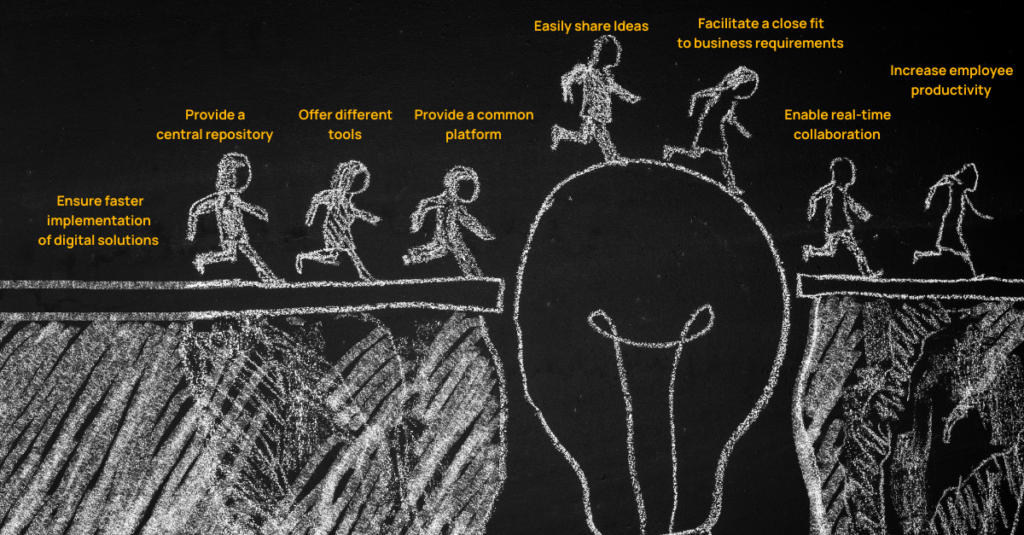By 2025, 70% of new applications developed by enterprises will use low code or no-code technologies, up from less than 25% in 2020—Gartner.
Low code, no-code offer a unified platform collectively used by development and business teams—each stakeholder can contribute their expertise directly. It fosters the co-creation of new applications, ensuring a collective buy-in and smoother rollouts whenever these applications are launched.
Moreover, the time saved during development liberates you from long, drawn-out development and change cycles. Instead, you are empowered to experiment at low cost and with minimal risk, and everyone is involved from the get-go.
In this article, we dive deeper into these concepts and explain how the low code platform Zvolv fosters collaboration, enhances productivity and facilitates seamless co-creation within organizations. But first,
What is Zvolv?
Zvolv is a hyper-automation platform that boosts the effectiveness of planning, execution, and operations teams. It enhances strategic decision-making using AI and ML, offering end-to-end integration and superior customization agility. It pairs knowledge and experience into high-performance processes and uses intelligent automation bots to tackle complex tasks.
Zvolv integrates seamlessly with third-party systems like ERP and CRM with simple yet powerful APIs. Businesses can quickly launch applications and iterate until optimized without worrying about technical aspects like servers, databases, security, or scalability. By providing real-time insights, Zvolv empowers decision-making, optimizes operations, accelerates growth, and promotes peak efficiency.
Boost Collaboration with Zvolv

- Easily Share Ideas
One of the significant benefits of using Zvolv is the ability to transform an idea into an application effortlessly. Effortlessly invite stakeholders—from seasoned developers to non-tech savvy team members—into the application development process. This democratization allows for diverse ideas and perspectives, encouraging creative problem-solving and fostering a collaborative culture. With Zvolv, building applications becomes an intuitive and inclusive process that opens up space for everyone to contribute, leading to robust and well-rounded solutions.
- Provide a Common Platform
A significant impediment to effective collaboration is disparate technologies and tools that isolate team members within their respective ‘tech silos.’ Let’s say, for instance, the design team is working on Adobe Suite to create visuals, the development team is using Jira for task management, and the sales team relies on Salesforce for CRM.
Each team is locked into its specialized tools, making it challenging to communicate effectively and share vital information across teams. This compartmentalization of tools and resources can lead to miscommunication, data duplication, and hindered visibility into cross-departmental workflows.
Zvolv, however, provides off-shelf integration that brings all these platforms together, eliminating the need for individualized tools and technologies. This shared workspace aids in effective communication and coordination, enabling teams to track progress and collaborate on documents, reducing the likelihood of miscommunication and oversight.
- Enable Real-Time Collaboration
Zvolv is a tool for application development and an enabler for real-time collaboration. According to Forrester, “enterprises that embraced low code platforms, digital process automation, and collaborative work management reacted faster and more effectively than firms relying only on traditional development.”
Zvolv’s sophisticated features facilitate the development and delivery of process-centric and project-centric applications that provide real-time tracking of progress and feedback implementation. This reduces the need for time-consuming emails and meetings, improving efficiency and productivity.
- Provide a Central Repository
In our information-rich age, having a central repository for data storage is crucial. Zvolv provides capabilities to establish such a repository, which becomes the single source of truth for the organization. This repository streamlines data retrieval, saving valuable time and effort and improving organizational efficiency.
- Offer Different Tools
Zvolv equips users with various tools and widgets that aid in application development and collaboration. For example, its latest Z-wall AI orchestration engine brings the power of generative AI to your application development. It helps organizations rapidly deploy the world’s best AI and automation capabilities. Similarly, enterprises can leverage its comprehensive widget library and state-of-the-art dashboard and workflow tools to boost productivity and collaboration.
- Ensure Faster Implementation of Digital Solutions
One of the pivotal advantages of Zvolv is its potential to expedite the creation and deployment of digital solutions. The LCNC approach reduces reliance on complex coding and technical expertise, thereby shrinking the time and cost needed to develop and deploy new solutions. It turns the IT team into more than a solutions provider—they can act as consultants only when needed while your team creates adaptable and modern applications.
- Facilitate a Close Fit to Business Requirements
Zvolv, with its LCNC approach, enables business users to participate in the development journey. As a result, the conveyed business requirements, wireframe, user interface, and user journey can be closely collaborated upon, creating applications that fit the business needs like a glove.
Let’s consider a scenario where a finance team deals with the complexity of budget allocation and expense management across various departments. They currently have a manual process that uses spreadsheets and emails to track expenses and allocate budgets, which is time-consuming, prone to errors and lacks transparency.
With the low code platform of Zvolv, the finance team can become active participants in the application development process. They can work with the developers to create a budget allocation and expense management application tailored to their needs.
Since Zvolv is intuitive and easy to use, some finance team members can take a more hands-on role in the development process. They can use the drag-and-drop features of the platform for prototyping parts of the application, such as creating forms for expense submission or dashboards for visualizing budget allocation.
They can provide insights into their daily tasks, pain points, and requirements to the IT team. The team can contribute to designing the user interface and journey to ensure the application is user-friendly and aligns with their workflows. This way, the finance team can collaborate with the development team throughout the application’s lifecycle and ensure the final application aligns with their requirements, significantly improves their work efficiency, and helps them manage the company’s finances more effectively.
- Increase Employee Productivity
Zvolv provides in-built commenting and collaboration tools that allow team members to leave feedback and suggestions on applications and workflows. This helps improve the quality of work and ensures everyone is on the same page, improving accountability and reducing the risk of errors. The outcome is an increase in productivity and a reduction in time spent rectifying mistakes.
The Future of Enterprise Applications with Zvolv
Introducing low code platforms like Zvolv into the organisation significantly reduces the pressure on technical teams. Low code platforms provide a shared workspace where developers, subject matter experts, and business analysts can directly contribute to the application development process.
A typical app development process involves many repetitive and routine coding tasks, which, although crucial, often do not require the full depth of developers’ skills and knowledge.
In the end, the use of low code platforms is a win-win situation for everyone involved. They speed up application development, improve the quality and relevance of the applications produced, and foster better collaboration between business and IT teams, freeing developers to focus on more complex and innovative tasks where their expertise can make a difference.
Want to know more?
Download the 7-day action plan to start evolving business processes on Zvolv.



